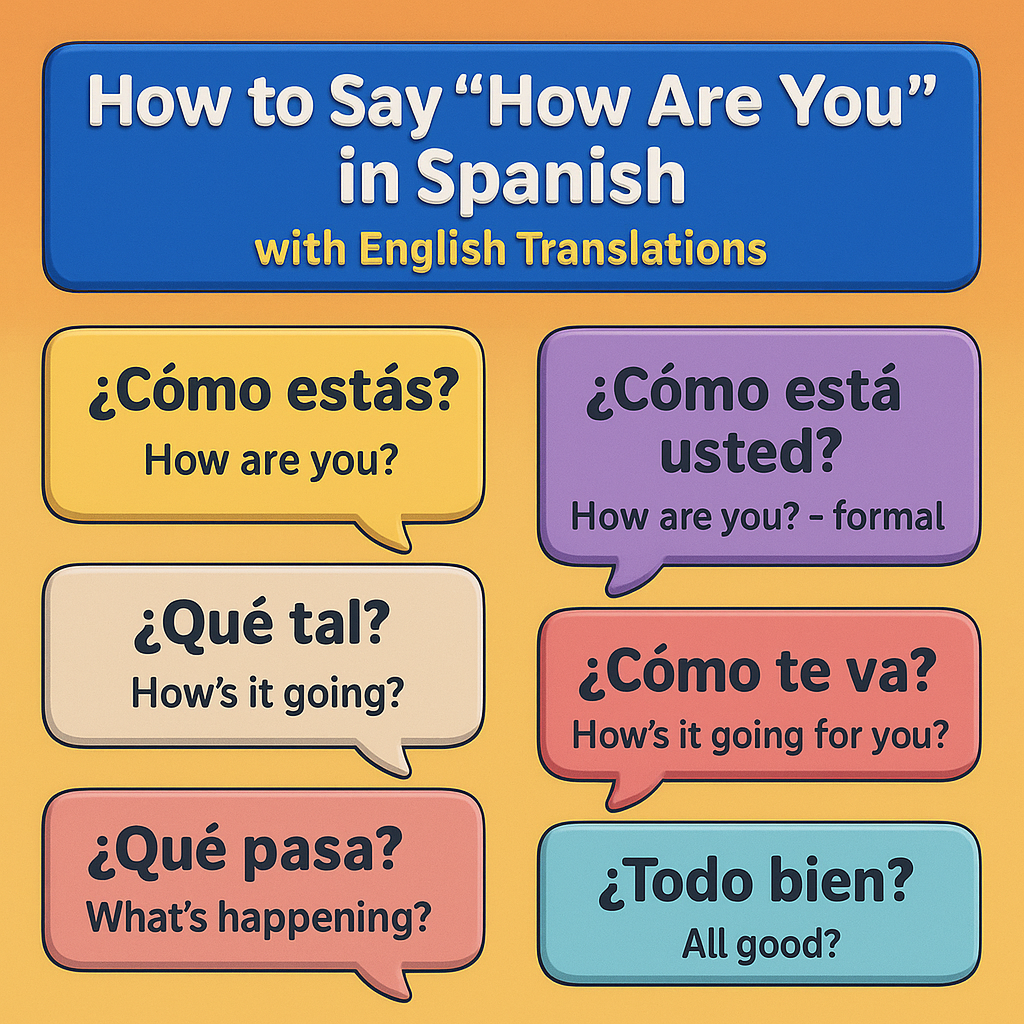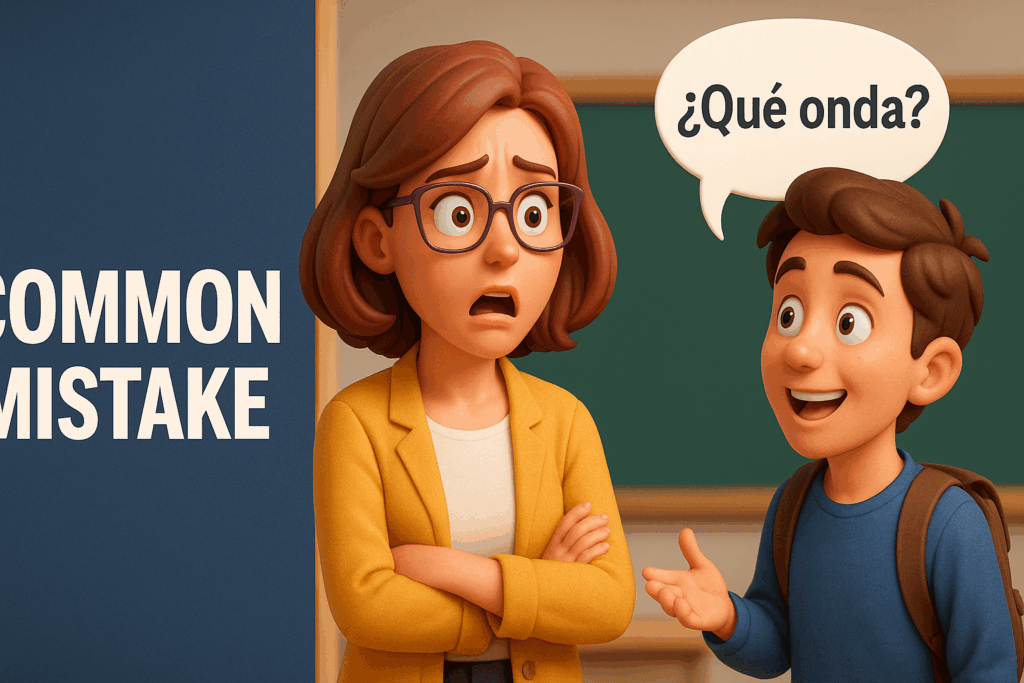Hola, my amazing learners! Today, we begin a brand-new lesson that every Spanish learner needs, learning the real, native-friendly ways to say “How are you” in Spanish in all types of situations.
Let me ask you: Have you ever paused before greeting someone in Spanish and thought…“Wait… should I say ¿Cómo estás?, ¿Cómo está usted?, or maybe something cooler like ¿Qué onda?*”?
You’re not alone! Spanish has a variety of greetings based on tone, setting, and relationship, and today we’ll break them down together.
You’ll learn:
- How to say how are you in Spanish formally
- Informal ways to ask how are you in Spanish
- How are you in Spanish slang (that real people actually use!)
- How to ask how are you in Spanish to a teacher or elder
- How to ask how are you in Spanish for beginners (without overthinking it)
- And even… how to respond to how are you in Spanish like a native!
We’re going to explore 12 authentic expressions, each with real-life examples and usage tips — not just dictionary definitions. Whether you’re chatting with a close friend, greeting your professor, or meeting someone for the first time in Latin America, this guide will help you choose the right phrase at the right moment.
So if you want to move beyond “textbook Spanish” and speak with confidence and natural rhythm — you’re in the right place.
Let’s dive in and learn to say “How are you?” like a native Spanish speaker.
Why It’s Important to Learn Different “How Are You” Greetings in Spanish?

Imagine this, You walk into a café in Mexico City and say, “¿Cómo está usted?” to a teenager behind the counter. He looks confused, maybe even a little amused. Why? Because that’s way too formal for that setting.
Now picture this: You meet your Spanish professor for the first time and greet her with “¿Qué onda?”.
That sounds like saying “Yo, what’s up?” to your school principal!
This is exactly why learning multiple ways to say how are you in Spanish is not just helpful — it’s essential.
Every situation — casual or formal, online or in-person, demands a different level of greeting.
That’s why I always recommend my students to understand:
- How to say how are you in Spanish formally, like when talking to your host family or a teacher.
- How are you in Spanish slang, so you don’t sound stiff around friends your age.
- How to ask how are you in Spanish to a teacher, which keeps your tone respectful and correct.
- And even things like how to respond to how are you in Spanish, because trust me, that question will come back to you.
As a beginner, you don’t need to learn everything at once. But you do need to recognize when it’s better to use:
- “¿Cómo está usted?” instead of “¿Qué tal?”
- Or “¿Cómo te va?” instead of “¿Qué pasa?”
Knowing these little switches can mean the difference between sounding polite and fluent, or awkward and unsure.
So don’t memorize just one phrase. Let’s learn the context, the emotion, and the culture behind each expression. That’s how you grow from a beginner to someone who sounds like they’ve lived in Spanish-speaking countries.
12 Real Ways to Say “How Are You” in Spanish
Alright, students — let’s get practical! You already know that “¿Cómo estás?” is the most popular way to say How are you? in Spanish. But what if you’re speaking to your boss? Or to a stranger in a professional setting?
Let’s explore six essential expressions, covering both formal and casual settings — so you can confidently greet anyone, anywhere.
1. ¿Cómo estás? – (How are you?)
This is your classic, friendly greeting. It’s informal, warm, and perfect for daily life.
Use it with: friends, classmates, younger people
Example: “Hola María, ¿cómo estás hoy?”
Works well when you’re practicing how to ask how are you in Spanish for beginners.
2. ¿Cómo está usted? – (How are you? – formal)
More polite and respectful. Use it with elders, teachers, or in interviews.
Use it with: your professor, someone older, or a client
Example: “Buenos días, profesora. ¿Cómo está usted?”
A must-know when you’re learning how to say how are you in Spanish formally.
3. ¿Qué tal? – (How’s it going?)
Casual and flexible. It can mean how are you or what’s up depending on tone.
Use it with: classmates, young coworkers, friends
Example: “¡Ey, Pedro! ¿Qué tal?”
One of the most popular informal ways to ask how are you in Spanish.
4. ¿Qué pasa? – (What’s happening?)
Very casual and slightly playful. Not literal, but used as a friendly “What’s up?”
Use it with: close friends, siblings, informal group chats
Example: “¿Qué pasa, tío? Hace mucho que no te veo.”
Common in everyday chats and a top choice if you’re into how are you in Spanish slang.
5. ¿Cómo te va? – (How’s it going for you?)
A thoughtful way to check in on someone. Slightly more personal than “¿Qué tal?”
Use it with: acquaintances, colleagues, neighbors
Example: “¡Hola Lucía! ¿Cómo te va con el nuevo trabajo?”
Helpful if you’re wondering how are things going in Spanish qué te trata la vida.
6. ¿Cómo te encuentras? – (How are you feeling?)
Often used in Spain. It’s polite and shows emotional concern — like asking about health.
Use it with: someone recovering, elder relatives, formal acquaintances
Example: “Buenas tardes, señor. ¿Cómo se encuentra hoy?”
Often searched as cómo te encuentras meaning how are you, especially in health-related conversations.
Suggestion: Learn 150+ Basic French Travel Phrases To Master For Your Next Trip To France.
12 Real Ways to Say “How Are You” in Spanish

You already know how to say “How are you?” in common ways like ¿Cómo estás? and ¿Qué tal?
But in real conversations, Spanish speakers often go further, especially when they want to express emotion, check in sincerely, or reconnect after some time.
Here are six more greetings that bring you closer to sounding truly natural in Spanish.
7. ¿Qué hay de nuevo? – What’s new?
This friendly phrase is perfect when catching up with someone you haven’t spoken to in a while. It’s casual but warm, and it shows genuine interest in the other person’s life.
“¡Hola! ¿Qué hay de nuevo contigo?”
This is great for reconnecting with friends, co-workers, or even friendly neighbors.
8. ¿Cómo te ha ido? – How has it been going?
Use this one when you want to ask someone how things have been — especially if you haven’t seen them recently. It’s thoughtful and meaningful.
“¡Carlos! ¿Cómo te ha ido desde que empezaste el nuevo trabajo?”
This greeting helps you move beyond surface-level conversation.
9. ¿Cómo andas? – How are you doing?
A relaxed, casual greeting common in Latin America. It’s like saying casual how are you in Spanish everyday.
“¿Cómo andas hoy? Te ves cansado.”
This works well with friends, cousins, or even coworkers in informal settings.
10. ¿Qué cuentas? – What’s going on with you?
It’s an open-ended greeting that invites the other person to share something — a bit more personal than just “Hi.”
“¡Tanto tiempo sin verte! ¿Qué cuentas?”
This phrase adds variety and warmth to your Spanish conversations.
11. ¿Qué onda? – What’s up?
Popular in Mexico, this is a qué onda meaning what’s up Spanish phrase — super informal and youthful. Think of it like “Yo, what’s up?” — great for casual chats or messaging.
“¿Qué onda, bro? ¿Vienes al cine esta noche?”
Stick to using this one with close friends or people your age.
12. ¿Todo bien? – All good?
Short and simple, but very effective. It’s used often in Argentina and Spain as a quick informal greeting in Spanish.
“¡Hola! ¿Todo bien?”
Perfect for texting, casual greetings, or even small talk at the supermarket.
These phrases give you more than just language, they give you connection. Whether you’re speaking with an old friend, meeting someone new, or just being polite, choosing the right greeting can set the tone for a great conversation.
Master these, and you won’t just be speaking Spanish, you’ll be living it.
Related: The 15 Most Common Grammar Mistakes In French And Our Guide To Avoid Them.
5 Common Mistakes Learners Make When Saying “How Are You” in Spanish

Now that you’ve learned 12 real expressions to ask “How are you?” in Spanish, it’s time for a reality check.
Even the best learners make simple but avoidable mistakes — mistakes that can make your greeting sound awkward, too robotic, or even rude.
Here are the top 5 mistakes my students often make — and how you can avoid them like a pro:
1. Using “¿Cómo estás?” for Every Situation
Yes, it’s the most popular phrase, but it doesn’t fit everywhere.
If you’re talking to your boss, a teacher, or someone older, ¿Cómo estás? might sound too casual. In formal situations, you should know how to say how are you in Spanish formally, like using ¿Cómo está usted?
- Rule: Use formal greetings when respect is expected.
2. Speaking Informally in Professional Settings
Imagine meeting your Spanish teacher for the first time and saying, “¿Qué onda?” That’s a clear no. You need to understand how to ask how are you in Spanish to a teacher or elder respectfully.
- Rule: Always match the tone to the setting, formal or informal.
3. Not Understanding Spanish Slang
Many students learn greetings from TV shows or TikTok, and start saying “¿Qué onda?” or “¿Qué pasa?” without knowing the context.
If you want to sound natural, learn how are you in Spanish slang, but use them only with the right people — friends, not strangers or elders.
- Rule: Slang is fun, but timing is everything.
4. Forgetting to Personalize the Response
Knowing how to respond to how are you in Spanish is just as important as asking the question.
If someone says “¿Cómo estás?” and you freeze, the conversation breaks.
- Rule: Always be ready to say something like “Bien, gracias. ¿Y tú?” or “Estoy un poco cansado, pero bien.”
5. Using the Wrong Phrase for Your Level
Some beginners try to sound advanced and use complex expressions too early. Start simple.
That’s why you should first focus on how to ask how are you in Spanish for beginners, like “¿Cómo estás?” or “¿Qué tal?”
- Rule: Keep it simple at first, clarity beats complexity.
Learning greetings is about more than vocabulary. It’s about knowing the person, the place, the purpose — and using the phrase that makes the other person feel comfortable.
So speak smart, not just fast, and you’ll never go wrong.
Quick Tips to Master Spanish Greetings Fast
Learning greetings is one thing. Using them naturally, that’s the real challenge. The good news? You don’t need to memorize all 12 phrases overnight.
Here are some smart, simple strategies I give my students to master Spanish greetings fast, and make them stick.
You May Also Like: Top 10 Apps To Master French In A Fun And Easy Way, Level Up Your Skills.
1. Practice Out Loud Every Day
Don’t just read silently. Say each greeting out loud — in the mirror, while walking, or even before going to bed.
Try this:
- ¿Qué tal? (How’s it going?)
- ¿Todo bien? (All good?)
Repeating these helps you build confidence in how to learn Spanish fast and speak naturally.
2. Use Flashcards With Audio
Make small flashcards with Spanish on one side and English on the other. Better yet — include audio using an app. That way, you learn the correct Spanish greetings pronunciation from day one.
Example card:
- Front: ¿Cómo te ha ido?
- Back: (How has it been going?)
3. Watch Native Speakers — Not Just Grammar Videos
You’ll absorb more by watching how people actually greet each other. Pay attention to shows, interviews, and YouTube channels.
Listen for things like:
- ¿Cómo andas? (How are you doing?)
- ¿Qué cuentas? (What’s going on with you?)
This is one of the best ways to improve Spanish greetings for beginners.
4. Use a New Greeting Each Day of the Week
Make a weekly challenge:
- Monday: ¿Cómo estás? (How are you?)
- Tuesday: ¿Qué hay de nuevo? (What’s new?)
- Wednesday: ¿Qué onda? (What’s up?)
- Thursday: ¿Cómo está usted? (How are you? – formal)
- Friday: ¿Qué pasa? (What’s happening?)
- Saturday: ¿Todo bien? (All good?)
- Sunday: Review Day
This helps you memorize daily Spanish expressions without pressure.
5. Join Language Exchange Apps or Groups
Apps like HelloTalk, Tandem, or Speaky allow you to talk to real native speakers — for free!
Try opening with:
- Hola, ¿cómo te va? (Hi, how’s it going for you?)
Then listen to how they respond. This builds fluency and teaches you how to respond to how are you in Spanish in real time.
6. Don’t Fear Mistakes — Just Use It!
The biggest barrier? Overthinking. If you forget whether to say ¿Cómo estás? (How are you?) or ¿Qué tal? (How’s it going?) — just pick one and smile.
Using what you know is better than saying nothing. And the more you use these greetings, the stronger your Spanish conversation muscles will become.
Also Check: Exploring French Slang: An Essential Part Of Conversational French.
FAQs About Saying “How Are You” in Spanish
1. What is the most polite way to say “How are you?” in Spanish?
The most respectful greeting is: ¿Cómo está usted? (How are you? – formal)
Use it when you’re talking to elders, professionals, or in official situations. It’s the best choice when learning how to say how are you in Spanish formally.
2. Can I say “¿Cómo estás?” to my Spanish teacher?
Not really. That’s too casual. Instead, use: ¿Cómo está usted? (How are you? – formal)
Understanding how to ask how are you in Spanish to a teacher is important if you want to show the right tone and manners.
3. What’s the difference between “¿Qué tal?” and “¿Cómo estás?”
Both mean How are you? — but:
- ¿Cómo estás? (How are you?) = more emotional, personal
- ¿Qué tal? (How’s it going?) = lighter, more casual
Knowing the difference helps you choose the right tone in casual or polite Spanish greetin
4. Which slang greeting is most common?
In Mexico, ¿Qué onda? (What’s up?) is the go-to slang.
If you want to learn how are you in Spanish slang, this is the phrase to remember.
Use it only with close friends, never in formal settings.
5. How do I reply when someone says “¿Cómo estás?”
Simple: Bien, gracias. ¿Y tú? (Good, thank you. And you?)
Or
Estoy un poco cansado, pero bien. (I’m a little tired, but fine.)
This is part of mastering how to respond to how are you in Spanish — something many learners forget.
6. What’s the best way to start as a beginner?
Stick with:
- ¿Cómo estás? (How are you?)
- ¿Qué tal? (How’s it going?)
These are safe, friendly, and easy.
It’s smart to begin with how to ask how are you in Spanish for beginners, then expand as you gain confidence.
Conclusion
Congratulations! You’ve now explored 12 real ways to say “How are you” in Spanish, learned when and how to use them, mastered pronunciation tips, and avoided common mistakes.
But here’s what truly matters: You don’t need to remember every single phrase at once. You just need to start using a few of them every day, in the mirror, with friends, or on language apps.

